On our first full day in Lithuania, we set off on foot to explore Kaunas, Lithuania's second largest city.
Heading out of our hotel, we headed up the hill and came to the park - Hill of Owls:
Our first stop was the Kaunas Our Lord Jesus Christ’s Resurrection Basilica (Kauno mūsų Viešpaties Jėzaus Kristaus Prisikėlimo bazilika). With a name that long, the basilica needed to be big, and it didn't disappoint (in fact it is the largest basilical church in the Baltic states). We had seen its spire as we headed into the city the night before, but walking down the street towards the basilica, we found that it seemed to suddenly just be there in front of us, tucked behind a large shopping building.
Unlike most of our normal tourist destinations, the church is fairly modern, consecrated in 2004 and finished in 2005.
It was decided that a new church was needed to thank God for the independence of Lithuania in 1918. The site was chosen and design approved in 1933. The cornerstone was brought from Mount Olive in Jerusalem and the church was mostly completed by 1940. Work was suspended during the Second World War - the Nazis used the church as a warehouse and the Soviets demolished the cross and chapel, turning the building into a radio factory.
The church was given to the council in 1988, but funding was slow due to the separation of church and state.
The tower of the basilica is 70m high and the church can hold 5000 people inside, and 2000 on the rooftop observation deck.
Our next stop was the Church of St Michael, the Archangel (Švento Arkangelo Mykolo Bažnyčia), also known as the Garrison Church.
These 'Garrison Churches' were built by the Russians in response to the uprisings, for the use of the military troops. The church was completed in 1895 and is 50m tall:
Directly behind the church was the main street of Kaunas, which stretched off into the distance - our next stop was down that way, so we wandered down the street which was very quiet for a Saturday:
 |
| Theatre - with an interesting sculpture |
 |
| Two metal men playing catch across the road |
 |
| Display about the war in Ukraine |
 |
| Statue of Vytautas Magnus, King of Lithuania |
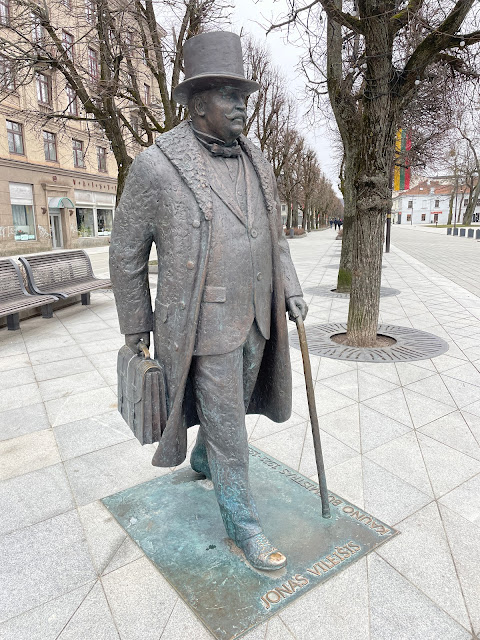 |
| Statue of Jonas Vileišis, a famous Lithuanian politician, lawyer and diplomat (1872-1942) |
 |
| Sculpture outside a cinema |
 |
| Danielius Dolskis, a Lithuanian Singer (1891-1931) |
 |
| Shells in the road as part of an art display |
Throughout our walk, we noticed bronze scallop shells embedded in many of the pavements. This shell is the symbol of Camino de Santiago (Saint James Way) - and they mark the way to the Cathedral of Santiago de Compostela in Spain (Galicia). This is a common pilgrimage and Kaunas is part of the Association of the friends of Saint James Way.
Next was another of Kauna's churches - Church of St. Gertrude (Šv. Gertrūdos bažnyčia), which is one of the oldest bright gothic churches in Lithuania. The exact date the church was built is unknown, but it is believed to be in 1400s.
We weren't yet ready to take a break from more churches, so our next stop was the Cathedral Basilica of apostles St. Peter and St. Paul of Kaunas (Kauno Šv. apaštalų Petro ir Povilo katedra bazilika). This church was first mentioned in 1413 and is believed to have been built in the early 1400s. It is 84m long, 28m high and 34m wide, making it the largest gothic church in Lithuania.
Just across from the church and across the river Nemunas, are the words"Kartu Kauna" meaning "Together Kaunas".
Near the cathedral was our next stop, the House of Perkūnas. The house was built in the 1440s by the merchants from the Hanseatic League, it was later ruined and rebuilt in the 1800s. It is one of the oldest and most original Gothic secular (non-religious) buildings in Lithuania. The name translates to "Thunder House" and the building is famous for its original facade using 16 different types of brick as well as the statue to the God Perkūnas (god of thunder).
Doubling back we headed to the Old Town Square, which houses the Town Hall (Kauno rotušė) as well as yet another church, that of the Church of St. Francis Xavier (Kauno šv. Pranciškaus Ksavero (Jėzuitų) bažnyčia).
The church was built by Jesuits in 1720 after they moved from their original site - a chapel in the House of Perkūnas.
The original Town Hall was built in the 1500s after the previous one was destroyed by fire. The building has been used as a trading hall, courthouse, prison, ammunition storage, orthodox church and of course as a town hall.
With its 53m tall tower, the building is called "The White Swan" and is now used for weddings, official city business and official ceremonies.
Behind the townhall were some interesting art works - a tribute to Vladislavas Starevicius (a Lithuanian cinematographer and animator), as well as the Fontanas Šunys (Dog's Fountain):
Our final stop in Kaunas was Kaunas Castle - believed to have been built in the mid 1300s, it is protected by the banks of Nemunas river, near where it joins the Neris river. About a third of the original castle still remains. The castle was overtaken by the Teutonic Knights in 1361. It was rebuilt and enlarged after the battle and before the work could be finished, the Teutonic Order retook it in 1384. The Teutonics renamed the castle Marienwerder and used it to threaten the Lithuanian castle define line along the River Nemunas.
Despite the knights having cannons and the Lithuanian forces having trebuchets, the Lithuanians retook the castle that same year and managed to hold it.
The Battle of Grunwald (1410) finished with the Polish-Lithuanian alliance defeating the Teutonic order, and Kaunas Castle was then not required for defence - becoming the residential castle.
Having finished with our whirlwind tour of Kaunas, we headed back to our car - stopping briefly to check out a small market and some of the local street art -
 |
| A fish dart board? |
It was now just after 11am and we headed to our next destination - The XI Fort (Ninth Fort). On the way out of the city we passed Vilijampolė, a former Jewish suburb that was turned into a ghetto when the Germans controlled Kaunas. A house at the entrance has been decorated as a memorial and titled "Burning Stones":
In the late 1800s the Lithuanians (under Russian control) created the Kaunas Fortress complex to help protect the western borders of Russia. Eight forts and nine gun batteries were built to surround Kaunas. The IX fort was started in 1902 and completed at the start of World War I.
Kaunas Fortress was attacked by the Germans in 1915 as part of their invasion of Russia, and it held for eleven days before falling. After the war, the new weapons made the fortress no longer useful, so the forts were used for other purposes. From 1924 the IX Fort was used as a prison and in 1940 it was used to hold political prisoners who were to be sent to the gulags.
Under Nazi occupation in World War II, the prison was used to house Jews from the Kovno Ghetto, who were killed in the Kaunas massacre (45,000-50,000 killed). After the war the Soviets continued to use the fort as a prison, and from 1948-1958 it was used as an administration building. Since 1958 it has been a museum and holocaust memorial.
There are several art installations on the walk from the carpark to the main fort:
 |
| View from the carpark back towards Kaunas |
Just outside the fort and next to the location where the Jewish citizens were murdered, is the Ninth Fort Memorial. It was unveiled in 1984 and is 32m high:
 |
| Cameron (in the white jacket) for scale |
We walked to the entrance of the fort, but didn't do the visit inside as we had to keep moving:
Our next stop was a two hour drive - The Hill of Crosses (Kryžių kalnas) in northern Lithuania.
It is believed that crosses were first placed on the hill just north of the city of Šiauliai after the uprising against the Soviets in 1831.
A large part of the post-war Soviet occupation that has come up as a theme throughout our visit so far was the religious suppression. The Soviets prohibited religious teachings, changed churches into other more functional buildings (Our Lord Jesus Christ’s Resurrection Basilica into a factory and Church of St. Francis Xavier into a gymnasium for example).
The Hill of Crosses became a sign of resistance against this, with the KGB bulldozing the site three separate times. The hill was eventually guarded, with pilgrims approaching being arrested and punished. In all cases the act of bringing crosses to the hill continues, albeit by cover of darkness.
After the independence of Lithuania the site became a tourist attraction and site of pilgrimage. Pope John Paul visited the site and his words are inscribed on a stone at the site "Thank you, Lithuanians, for this Hill of Crosses which testifies to the nations of Europe and to the whole world the faith of the people of this land."
The first count of crosses in 1900 was 130. In 1938 there were over 400, and when the site was bulldozed in 1961 it was approximate that there were 5,000. It was estimated that there were 55,000 crosses in 1990 and over 100,000 in 2006.
It was an interesting site with a huge range of crosses, rosaries and religious symbols all in various states of decay - some scattered seemingly randomly or piled on larger statues and some in a semblance of an orderly row.
A main walkway goes to the top of the hill, where I expected the crosses to end, but instead there was a second ridge even more heavily covered than the other. The crosses have also spread out to each side of the hill, partially surrounding the entry courtyard. Small crosses were for sale at the entrance of the area and we purchased a small one, which we placed under a tree on the southern side of the hill.
It was hard to capture the full scale of the site in photos, but hopefully some of it comes across below:
 |
| First view as we approached |
 |
| Panoramic of the entrance |
 |
| The extension down the right side |
 |
| The main path |
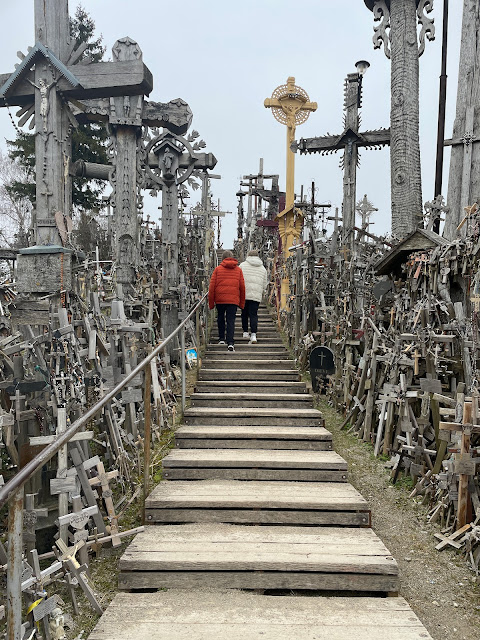 |
| Heading up the main path |
 |
| Passing over the first ridge into the second part |
 |
| Our cross |
Placing our cross:
After finishing up at the Hill of Crosses, we drove into Vilnius and arrived at our hotel, the AJ Chocolate Guesthouse.
 |
| A massive tread being transported |
 |
| Easter lamb bread |
 |
| A vending machine at our hotel with sardines |
 |
| AJ Chocolate House |















































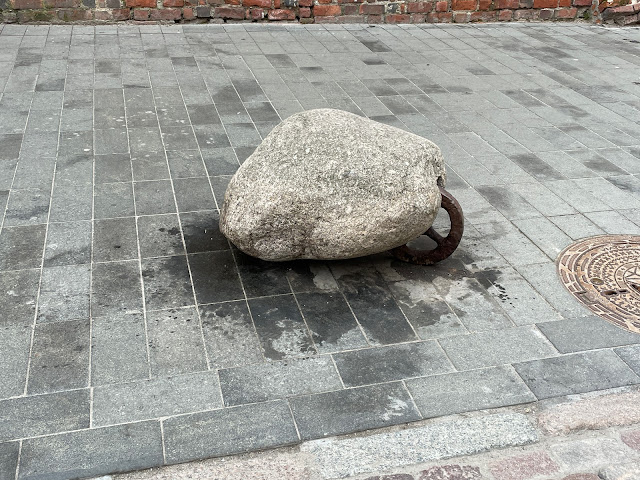










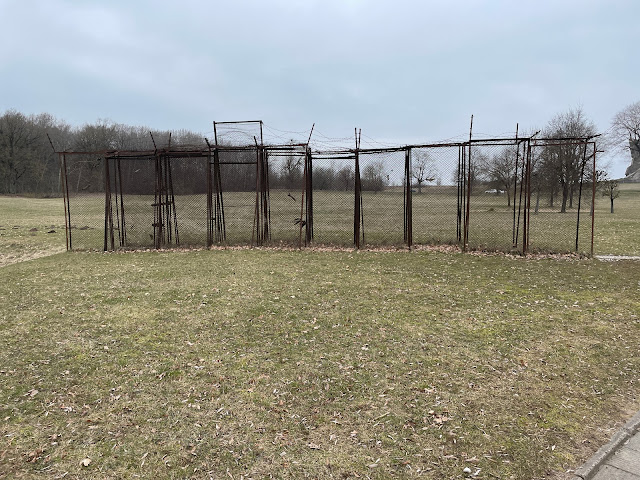
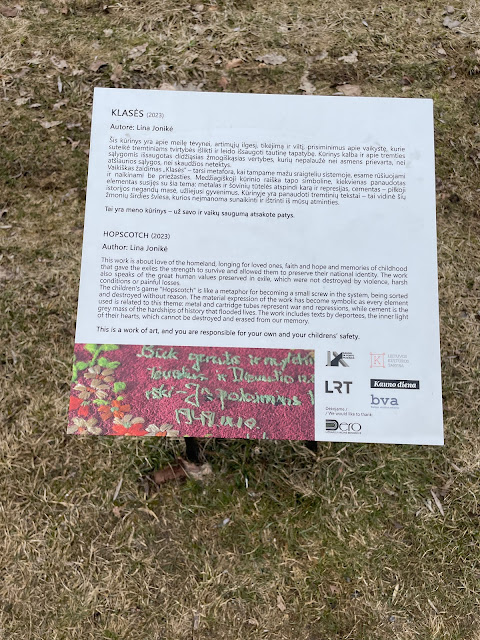


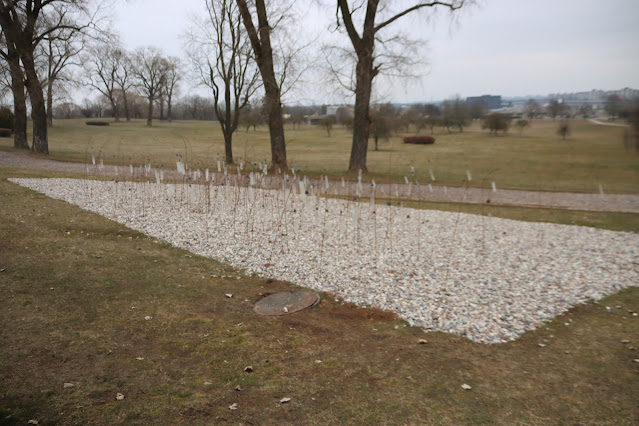






























No comments:
Post a Comment